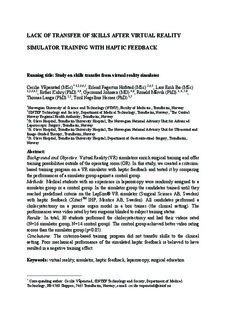Lack of transfer of skills after virtual reality simulator training with haptic feedback
Våpenstad, Cecilie; Hofstad, Erlend Fagertun; Bø, Lars Eirik; Kuhry, Esther; Johnsen, Gjermund; Mårvik, Ronald; Langø, Thomas; Hernes, Toril A. Nagelhus
Journal article, Peer reviewed
Accepted version

Permanent lenke
http://hdl.handle.net/11250/2442706Utgivelsesdato
2017Metadata
Vis full innførselSamlinger
Originalversjon
10.1080/13645706.2017.1319866Sammendrag
Background and objective: Virtual reality (VR) simulators enrich surgical training and offer training possibilities outside of the operating room (OR). In this study, we created a criterion-based training program on a VR simulator with haptic feedback and tested it by comparing the performances of a simulator group against a control group.
Material and methods: Medical students with no experience in laparoscopy were randomly assigned to a simulator group or a control group. In the simulator group, the candidates trained until they reached predefined criteria on the LapSim® VR simulator (Surgical Science AB, Göteborg, Sweden) with haptic feedback (XitactTM IHP, Mentice AB, Göteborg, Sweden). All candidates performed a cholecystectomy on a porcine organ model in a box trainer (the clinical setting). The performances were video rated by two surgeons blinded to subject training status.
Results: In total, 30 students performed the cholecystectomy and had their videos rated (N = 16 simulator group, N = 14 control group). The control group achieved better video rating scores than the simulator group (p < .05).
Conclusions: The criterion-based training program did not transfer skills to the clinical setting. Poor mechanical performance of the simulated haptic feedback is believed to have resulted in a negative training effect.